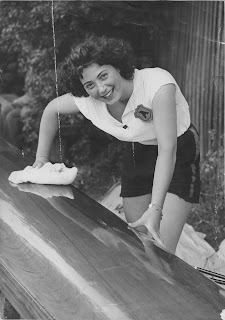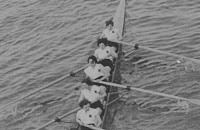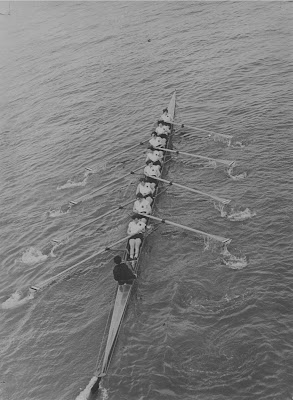Since then, boats, blades, kit, training, standards and the size of events have been transformed. But have the young racers of today really "never had it so good"? Or does the very popularity of women's rowing nowadays, which makes it harder to win, mean that "the good old days" were actually better?
 |
| Putting club stickers on your car = doyenne status. (I don't suppose it's coincidence that Pauline's car's black either.) |
Catching her after a recent training session, I pressed her for details about how things really were back then.
Training
During the winter, water outings were strictly limited to daylight hours, which meant Saturday afternoons (as it was common for most people, even office workers, to work on Saturday mornings in the 1950s) and Sunday mornings. As today, evening land training sessions during the week involved circuits but, as the club didn't have any weights to add resistance in relevant exercises, they improvised with bricks wrapped in newspaper to help "build" their strength (couldn't resist that).
Afterwards, Pauline would get the bus home, but as she was a junior, her parents only agreed to this once the club Captain had written to them promising that someone would always see her onto the bus.
Midweek training only happened a couple of nights a week back then, though, and even in the late 1960s and early 1970s anyone who wanted to train more often had to find some way of getting past the "but the club isn't open" attitudes of the time. It really isn't any wonder that Britain didn't win any gold medals in rowing at the Olympics between 1948 and 1984, is it?
Equipment
Boats and blades back then were wooden, of course, but unlike today, the type of boat you rowed in defined your racing category. There were shells (like today's boats), "restricteds" (which had a 2-3cm deep keel running along the bottom which allegedly made them easier to balance although I have to say I never noticed much that was stable about the restricted boat I rowed in as a novice), and then the clinkers (constructed from overlapping planks, the most traditional design).
With separate prizes for each and perhaps only ten crews in the WEHORR compared with the 320 who will be racing in a couple of week's time, your statistical chances of winning were certainly higher than today!
 |
| Always wipe your boat down, no matter what century it is. |
Transporting them was a massive challenge too, and another reason why entries at the WEHORR remained low for many years. Restricteds and clinkers couldn't be sectioned, so the only way of transporting them was to load them whole onto a builder's lorry. Pauline has a memory of members of Bedford Ladies RC bringing their blades on the train to row on the Tideway in a borrowed boat, although how they got from Kings Cross station to Putney with them is unclear.
One thing that hasn't changed, though, is the importance of wiping down boats – a task that the ladies of Alpha naturally delegated to the youngest member of their crew. The photo on the right appeared in a local paper under the heading "A job for the games captain" (a role the young Pauline held at Richmond County School). It is debatable whether the cheesiness of this title and, indeed, the focus on cleaning when reporting women's sport, is attributable to the social mores of the time or simply the enduring habits of local journalists. Probably both, actually.
Kit
 |
| Cosy winter kit à la 1954. |
And if that wasn't bad enough, the real problem with kit back then was that this was basically all there was! Tracksuits hadn't yet been invented (and even when they did start to appear in the 1960s1, they were prohibitively expensive), and neither had tights (the concept of rowing with woolen stockings and suspenders under one's rowing shorts doesn't even bear thinking of) and anyway, it was deemed character building that sportspeople just wore shorts all year round.
In minor deference to the British winter (and spring, summer and autumn as well, in fact), Pauline does remember having a long-sleeved, cricket-style jumper, which she is pretty sure came from a jumble sale and, of course, got soaked as soon as you took it off and put it in the bottom of the boat (no enclosed hatches back then).
Boats had "clogs" which were like today's ergo feet but involved a wooden footplate, brass heel cups, and leather straps, rather than full shoes. You can just about see in the picture above that Pauline is wearing "plimsolls": again with proper running trainers still being far in the future (they were only really developed when the jogging craze started in the 19702), this is all there was for athletic footwear. As land training also involved running, I can only imagine that shin splints were practically an occupational hazard for rowers at the time.
Long or short? A strange decision
At the time Pauline first raced in the WEHORR, the event was only just getting going again after the
Second World War. And although it had first been raced in a processional format in the 1930s over the full four and a quarter miles championship course from Mortlake to Putney, when it restarted in 1950 the course was shortened to two miles, from the White Hart to Hammersmith, on the grounds that the full course would be "too much" for competitors after years of rationing3.
The robustness of the "weakened by rationing" theory as a valid reason for rowing the short course is certainly thrown into doubt by the facts that the men's Head of the River Race (HORR) had gone straight back to being raced over the full course when it had restarted in 1946, and that the WEHORR continued to use the short course well into the 1970s despite rationing ending in 1954.
As a women's-only event largely run by women, the WEHORR should have been relatively free of the views frequently proffered by men for why women's rowing events should be less demanding than those for men (women's events were only added to the World Rowing Championships in 1975, and it wasn't until 1988 that they raced the full 2,000m distance at Olympics, after all). Did the organisers at the time genuinely believe the "weakened by rationing" theory, even though their colleagues on the HORR committee clearly didn't? Or did they think that offering the short course would attract more competitors, but that they needed a "blameless" reason for doing so? And did they even get round to revisiting the matter each year? It would certainly be fascinating to trawl the race's archive for minutes from the era.
That said, offering only the short course was probably a wise move by the time the it got to the first half of the 1960s. Pauline remembers crews failing to finish the race on several occasions because they weren't fit enough as well as having "abysmal" technique, although the latter can at be least partly attributed to a lack of people prepared to coach women.
Which was better, then or now?
 |
| Pauline's rowing career is well into its seventh decade. She continues to work on her catch. |
You know the answer, don't you? Not likely!
Postscript
Last year, I coxed Pauline's at an early-season head on the Tideway in preparation for the WEHORR in a Masters F VIII average age 60+).
Whilst sitting around marshaling, we found ourselves alongside a crew of young women. We got chatting, and one of them asked what status we were. We explained. Her eyes widened and she exclaimed, "Cool! You're like, old enough to be my mum!" "Actually", I replied, "half the crew's old enough to be your GRANDMA!"
I think, and for the purposes of this story let's stick with this, that we beat them. The moral of this tale, therefore, is that there's the very best option isn't then OR now, but rather it is to have rowers who were toughened in the bad old days, but in my boat and racing today.
References
1 Tracksuit, Wikipedia. Retrieved 15 February 2016.
2 Sneakers, Wikipedia Retrieved 23 February 2016.
3 Women's Heights Head of the River website, Retrieved 14 February 2016.
All photos are from Pauline's personal collection. apart from the one of her car and the one of her in the pink jersey which are © Helena Smalman-Smith. The "Cosy winter kit" photo is © Wing Features press photographic service. The "Always wipe your boat down" one is © Fox Photos Ltd.
1 Tracksuit, Wikipedia. Retrieved 15 February 2016.
2 Sneakers, Wikipedia Retrieved 23 February 2016.
3 Women's Heights Head of the River website, Retrieved 14 February 2016.
All photos are from Pauline's personal collection. apart from the one of her car and the one of her in the pink jersey which are © Helena Smalman-Smith. The "Cosy winter kit" photo is © Wing Features press photographic service. The "Always wipe your boat down" one is © Fox Photos Ltd.


Heart warming stuff. It's so interesting to hear of the 'careers' of regular rowers, not just the elite sports professionals.
ReplyDelete